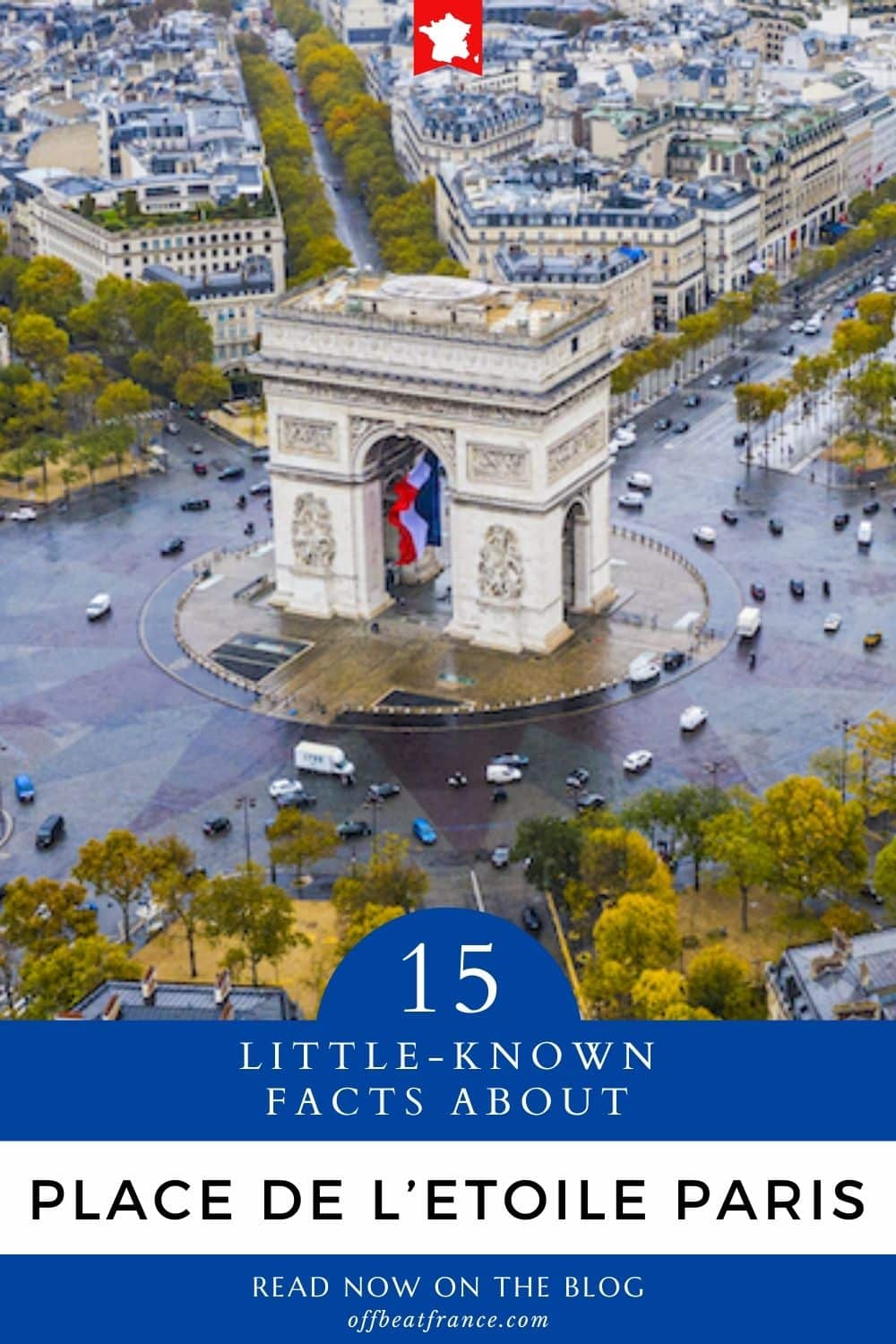Unsure about your French table manners? Click Here to download > > How to avoid these 10 food etiquette mistakes !
- Home ›
- Destinations ›
- Paris ›
- Most Famous Roundabout in Paris
15 Quirky facts about Étoile, the most famous roundabout in paris
Updated 29 July 2024 by Leyla Alyanak — Parisian by birth, Lyonnaise by adoption, historian by passion
Welcome to the zaniest, craziest and most famous roundabout in Paris. Enter at your own risk! As for me, I'll stick to the edges, thank you very much.
If you've ever stepped into traffic on the Place de l'Étoile by mistake, you've probably jumped back in terror as cars sped straight towards you.
It is a crowded square, with traffic rules Parisians often choose to ignore (and which only Parisians seem to understand).
But one thing we all agree upon: the Place de l'Étoile is for cars, not people. Any pedestrian who dares step on the street for a selfie with the Arc de Triomphe is fair game.
Welcome to the most famous roundabout in Paris, in Europe even. The 12 grand avenues that join it give it the shape of a star (étoile means star in French) that can be seen from the window of an airplane. It is an eternal symbol of Paris.
Now, the city's mayor, Anne Hidalgo, wants to change the sacrosanct roundabout to improve it for pedestrians. Parisians, of course, are up in arms, both for and against.
If she has her way, four of the 12 lanes of traffic will disappear, and space for pedestrians – to edge closer to Instagram heaven – will increase. (The only way to cross the square is by taking an underground passageway that leads to the arch in the middle.)
A refitting, says pundit John Litchfield in The Local, would destroy "a symbol of Parisian exceptionalism, a microcosm of France, an automotive wonder of the world".
Whether this will happen is still unclear.
THE GEOGRAPHY OF THE PLACE DE L'ÉTOILE
- It is shaped like a star and is 241m / 790ft across (only Place de la Concorde is larger in Paris)
- It is shared by the 8th, 16th and 17th arrondissements
- It is one of the most prestigious addresses in Paris
- 12 avenues lead off from it: Wagram, MacMahon, Carnot, Grande Armée, Foch, Victor Hugo, Kléber, Iéna, Marceau, Champs-Élysées, Friedland and Hoche - many of these are connected with Napoleon
- More than 110,000 vehicles cross the Étoile in Paris every day
- In its center is the magnificent Arc de Triomphe, or triumphal arch, which can be reached via an underground passageway
15 Quirky facts about the Place de l'Étoile
The Place de l'Étoile, or Square of the Star, is almost inevitable. At some point, you'll end up here, whether you're walking up the iconic Champs-Elysées, visiting the Arc de Triomphe, or heading off to explore the city.
You'll definitely cross it if you tour Paris by bus. To get up close and personal, do this: take a tour of Paris in a Citroen 2CV and cross the Etoile. Just take a deep breath and go with the flow! At least you won't be behind the steering wheel...
If you are driving (these tips should help), don't forget these two rules: 1) give way to traffic coming from your right, and 2) remember that – contrary to the usual roundabout etiquette – people entering the roundabout have the right of way.
And now, some things you might not know about this famous roundabout in Paris!
1. The Etoile was once a toll gate
During its history, Paris was often "protected" by barriers. Some were gates, beyond which no construction was allowed, and others were walls punctuated by toll stations, where a certain tax, the "octroi", had to be paid. Paris had six of these.
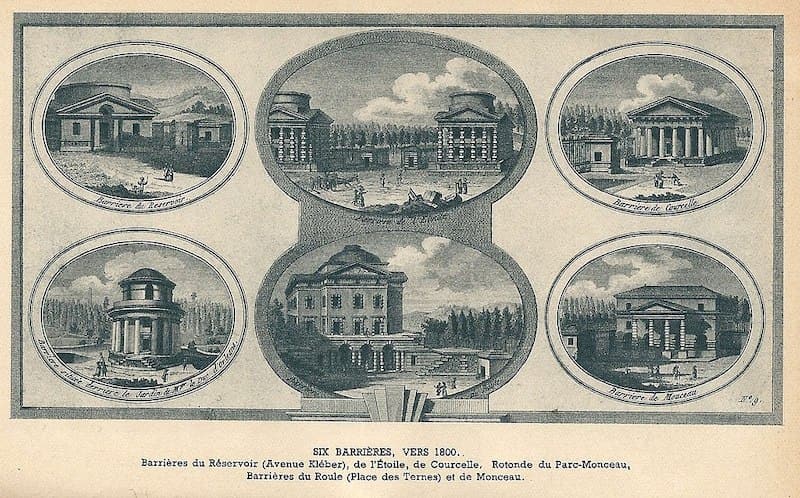
The Place de l'Etoile had two such toll houses, built by Claude-Nicolas Ledoux, my favorite French architect, responsible for the Royal Saltworks and some of the quirkiest architecture of the 18th century. Sadly, the two buildings were razed in 1859.
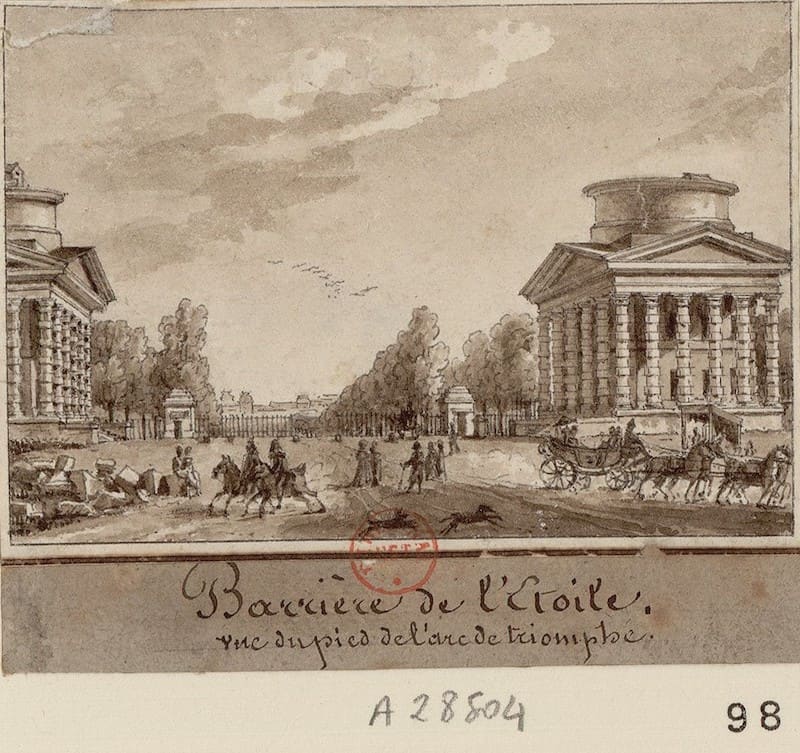 Source gallica.bnf.fr / Bibliothèque nationale de France
Source gallica.bnf.fr / Bibliothèque nationale de France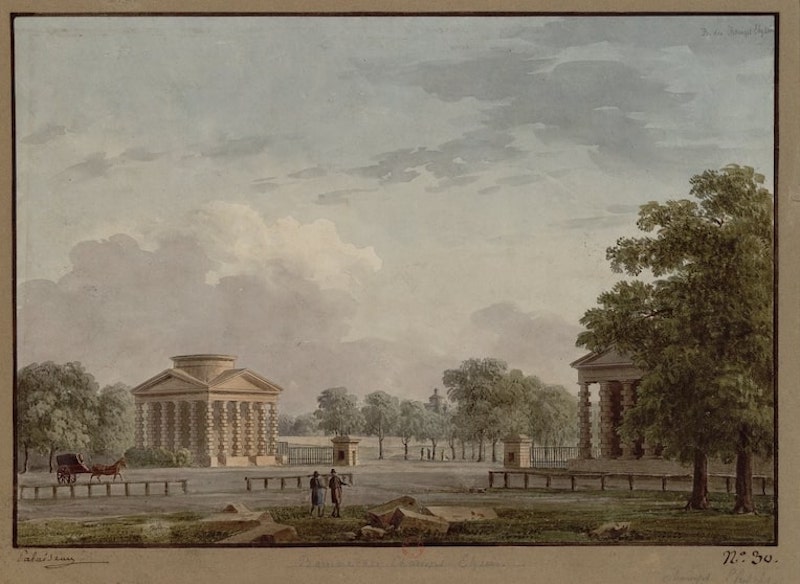 Source gallica.bnf.fr / Bibliothèque nationale de France
Source gallica.bnf.fr / Bibliothèque nationale de France2. The Place de l'Étoile was France's first roundabout
France claims we invented roundabouts. Although we can proudly point to hundreds of inventions, the roundabout isn't one of them.
The idea of cars circling in one direction came from Britain in 1897 – until then, cars zigzagged every which way when they reached a crossroads. A French city architect, Eugène Hénard, picked up on the idea and so, in 1906, the Place de l'Étoile was born.
From that modest start, popularity grew, and today, about half the world's roundabouts are located in France. My own village of 1200 people has four...
3. Etoile is not its real name
Known as the Place de l'Étoile for most of its existence, in 1970 it was rechristened Place Charles de Gaulle. But old habits die hard, especially in France. For many of us, it will always be known as l'Étoile.
In the same rebellious vein, Parisians won't call Charles de Gaulle airport by its name. Instead, we still call it Roissy, after the village which hosts it.
4. Building the arch was decreed by Napoleon
After he won the decisive battle of Austerlitz against Russia and Austria, Napoleon Bonaparte issued an imperial decree and told his victorious forces: "You will only enter your homes through triumphal arches".
In 1806 he decided to build a monument to commemorate the French army's victories during the Napoleonic Wars, but he would be long dead before the work was completed.
If you're fascinated by buildings, here's what I'm reading right now: The Architecture Lover's Guide to Paris – and thoroughly enjoying it. An educated book without being overly arcane, a bit like visiting Paris with a knowledgeable and passionate friend. Buy on Amazon
5. Instead of an arch, we almost had an elephant
Napoleon didn't originally picture an arch on the Place de l'Étoile.
The French Revolution was now over, and a perfect place for his monument to the Grande Armée would be... the Bastille.
But here, opinions differed.
With the Champs-Élysées being rapidly upgraded, the appeal of this upper-crust neighborhood was too much to resist.
But what kind of monument should it be? Again, discord.
Some people wanted a fountain, others suggested a cross.
But Napoleon wouldn't abandon his Bastille project: he wanted a giant bronze elephant, spouting water from its trunk.
Given the tastes of the times, we could easily have ended up with a cross on the Place de l'Étoile, and an elephant at the Bastille... or vice versa.
Thankfully, we eventually got the arch.
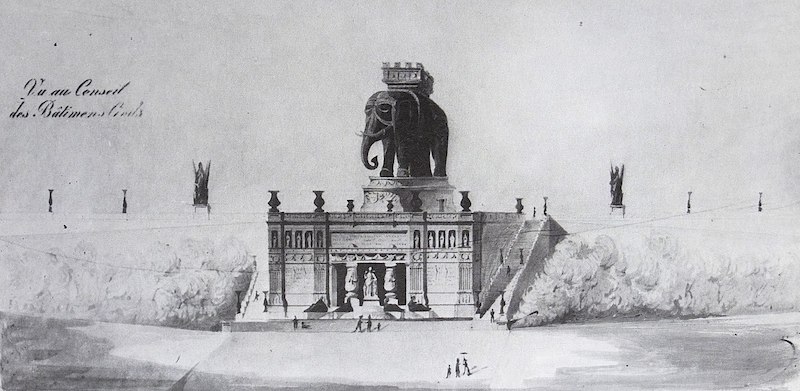 What the Place de l'Etoile MIGHT have looked like. Prisma einer Stadt, Zürich 1978, Public domain, via Wikimedia Commons
What the Place de l'Etoile MIGHT have looked like. Prisma einer Stadt, Zürich 1978, Public domain, via Wikimedia Commons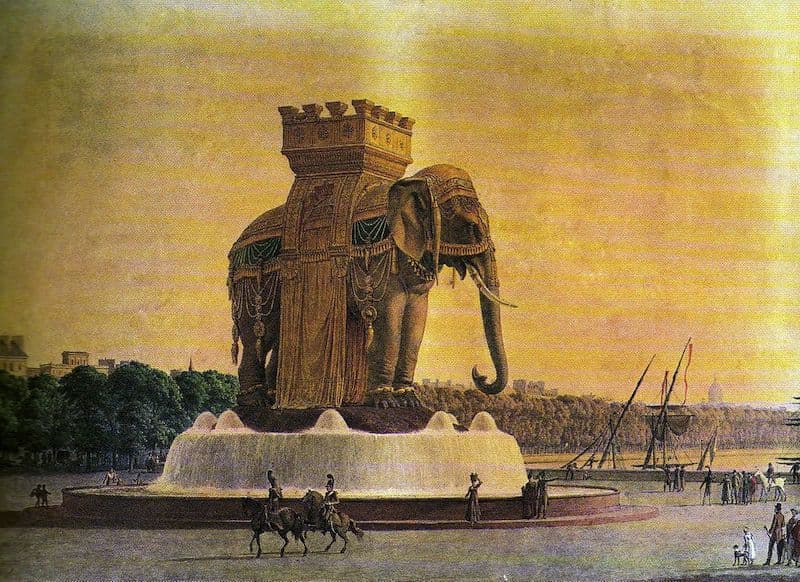 What was planned for the Place de la Bastille. Michel Louis Viguet, published in Yvan Christ, Paris des utopies, éditions Balland, Paris, 1977
What was planned for the Place de la Bastille. Michel Louis Viguet, published in Yvan Christ, Paris des utopies, éditions Balland, Paris, 19776. A make-believe arch was erected for the Emperor's wedding
When Napoleon married Marie-Louise of Austria in 1810, the arch wasn't finished yet. But escorting her from the site of the civil wedding (Saint-Cloud) to the religious wedding (Louvre) meant cutting through the Étoile and its unfinished monument.
That wouldn't do, so a life-sized model was built in wood and cloth to allow the Emperor and his new wife to pass through.
The facsimile would also give the emperor and everyone else a good idea of what the final structure would look like!
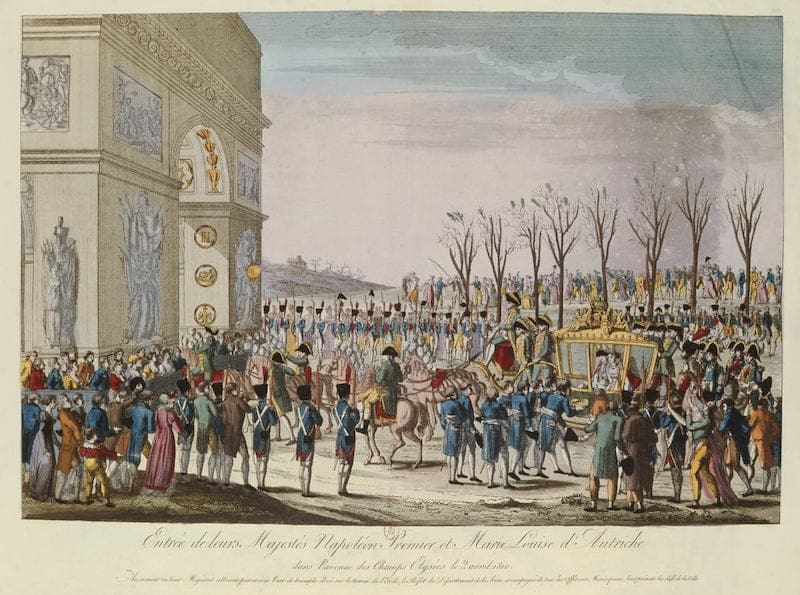 Fake arch built for Napoleon's marriage to Marie-Louise of Austria
Fake arch built for Napoleon's marriage to Marie-Louise of Austria7. Napoleon never saw the finished arch
Napoleon would never see his military monument. He would die in 1821, before the arch was finished.
With the Bourbon dynasty restored, King Louis XVIII wasn't too keen to promote Napoleonic symbols. It would take King Louis-Philippe, the Citizen King and France's penultimate monarch, until 1836 to complete construction.
But the emperor did see another one: the Arc de triomphe du Carrousel, designed as an entrance to the now disappeared Palais des Tuileries, was inaugurated in 1809 to celebrate his victories. More modest than the grand Etoile project, it at least had the benefit of being completed in his lifetime.
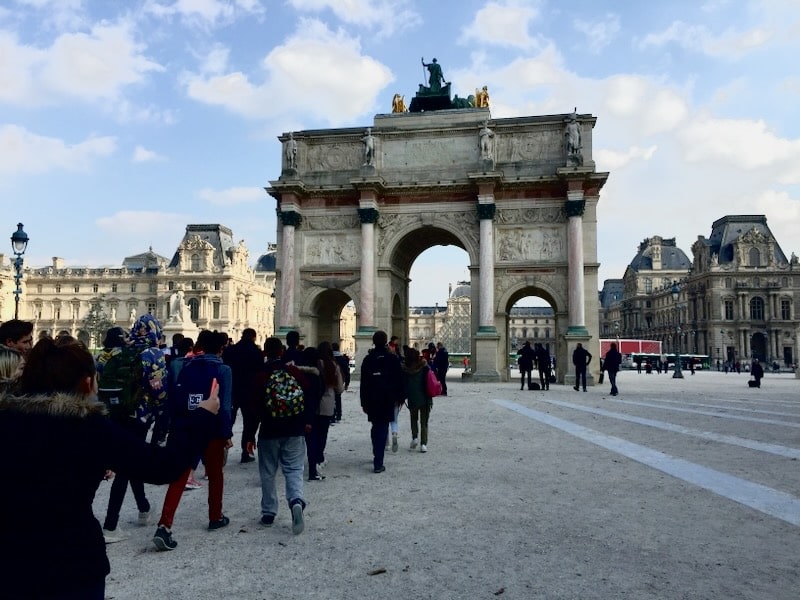 Napoleon's "other" Arc de Triomphe
Napoleon's "other" Arc de TriompheHEADED TO FRANCE? YOU MIGHT FIND THESE USEFUL...
➽ An infinity scarf,: to conveniently stash your keys and cards and avoid pickpockets
➽ A great guidebook published by a French-based company
➽ An anti-theft purse (I've had THREE of these) or daypack to carry your larger items
8. Its inauguration was kept nearly secret
The opponents of the arch had been grumbling. Fearing an attack, organizers decided to keep the inauguration very private – only 11 people attended.
But that didn't stop the crowds from gathering beneath its 700 new gas lights...
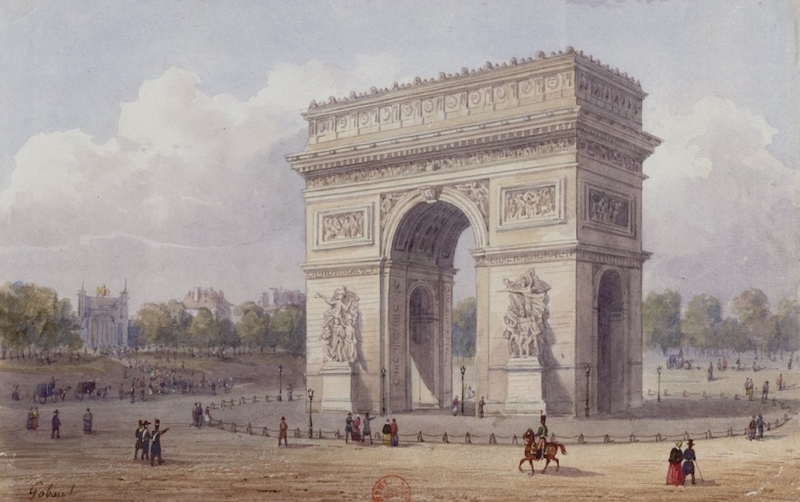
MEANING OF THE 12 "STAR" AVENUE NAMES
- Wagram: site of a Napoleonic victory in 1806
- MacMahon: Marshall, led fight against Parisians during 1871 Paris Commune (short-lived revolutionary government)
- Carnot: General, intellectual, politician during the Directory (1795-1799)
- Grande Armée: Great Army, nickname of Napoleon's war machine
- Foch: Marshall, a great World War I figure, signatory of the armistice
- Victor Hugo: French literary legend and vocal opponent of Napoleon III
- Kléber: General, architect, took part in Napoleon's Egyptian campaign
- Iéna: Napoleonic victory in 1806
- Marceau: General, hero of the French Revolution, member of the National Guard
- Champs-Élysées: big, bold, beautiful, takes its name from Greek mythology (Elysean Fields, final resting place of heroes)
- Friedland: site of 1807 Napoleonic victory
- Hoche: General, revolutionary wars
9. Another Napoleon was responsible for the Arc de Triomphe roundabout
As for the roundabout itself, it would take another Napoleon to complete it: Napoleon III, nephew of the first.
Under the wrecking ball of Baron Haussmann, Prefect of Paris during the Second Empire, 12 new avenues were pierced in Paris, converging upon the Place de l'Étoile and turning it into the roundabout we know today.
10. The arch was draped in black for Victor Hugo's funeral
Victor Hugo was a national literary treasure and his death brought out the crowds. Vantage points sold for small fortunes, and nearly two million people gathered at the Place de l'Étoile to follow the funeral procession to the Pantheon.
The Arc de Triomphe wore a billowing black veil for the occasion.
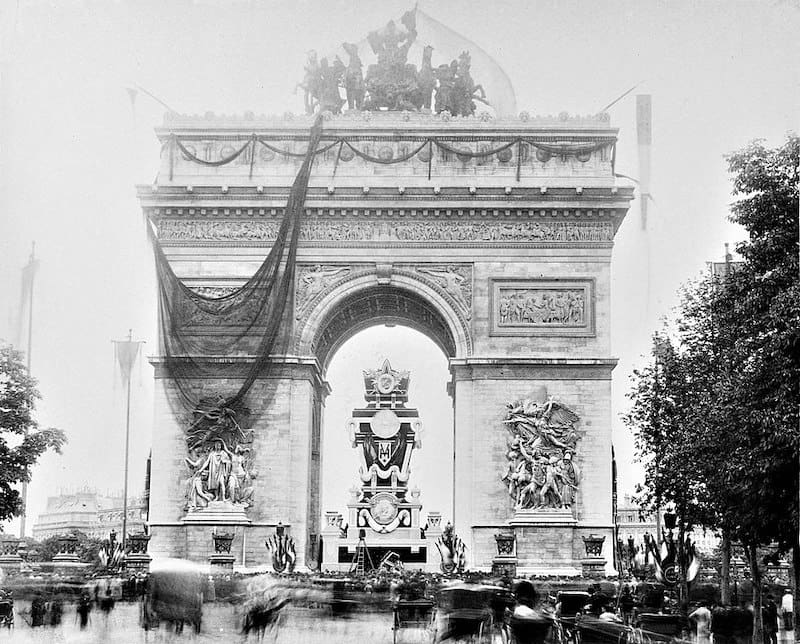
11. A plane flew through the arches in 1919
Each year, on Bastille Day on the 14th of July, there's a military parade down the Champs Elysées and an air show in the skies of Paris.
Back in 1919, there weren't any jets with red, white and blue plumes yet – but a pilot took things into his own hands: having been told pilots would have to march on foot, they felt insulted.
To rectify this, ace pilot Charles Godefroy took off from the Villacoublay airfield, circled the Place de l'Étoile twice, flew off to get a bit of distance, and swerved towards the Arc de Triomphe.
Spectators were terrified as he swooped down towards the opening, narrowly squeezing through the arch.
He lost his licence.
12. In 1920 the Unknown Soldier was buried here
On 11 November 1920, two years after the World War I armistice, the tomb of the "unknown soldier" was inaugurated.
How was he chosen?
His was one of eight soldier coffins held in the Verdun citadel – each coffin represented one of eight regions having suffered the most during the war.
A young soldier whose father had been killed in the war was given the task of choosing which of the eight would be brought to his final resting place in Paris.
The soldier was part of the 132nd infantry regiment: "By adding up these numbers, I get six. I've decided. Starting on the right, I'll choose the sixth coffin I count."
Each day, the Eternal Flame of Remembrance is rekindled at 6:30pm in commemoration.
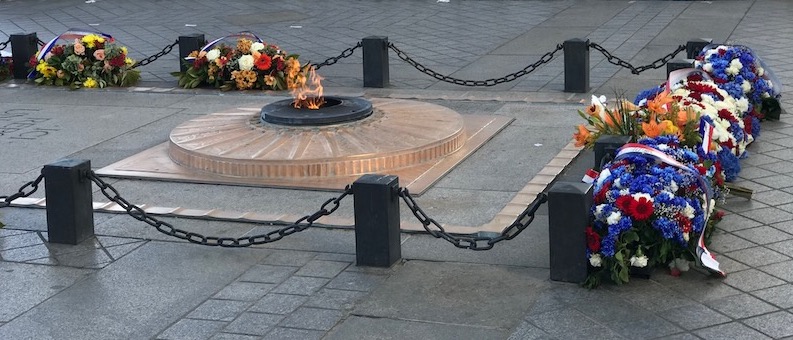
13. It was wrapped
In 2021, we awoke to a very different Arc de Triomphe.
The late artists Christo and Jeanne-Claude had planned a display every bit as controversial as the glass pyramid of the Louvre or the Centre Pompidou had been in their day.
I made it a point to visit Paris to see this unique artwork and to go up to the top of the wrapped arch. Who could resist?
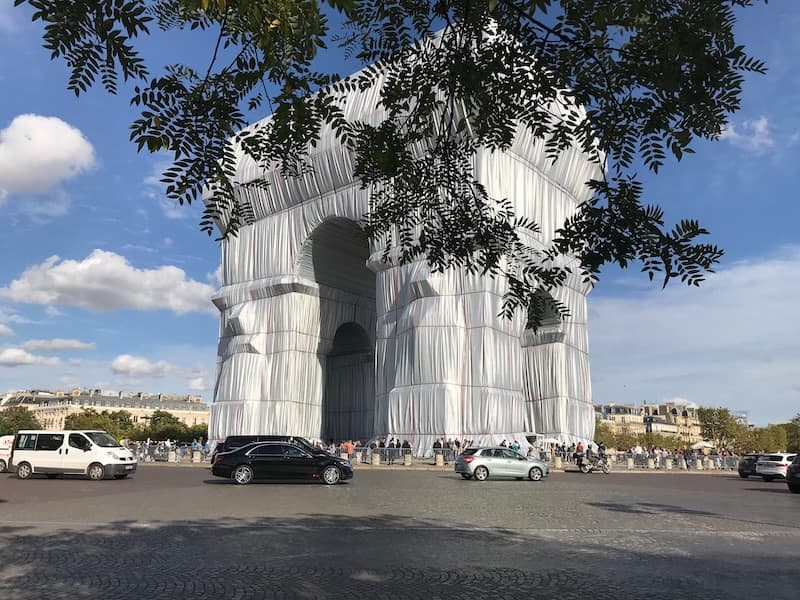
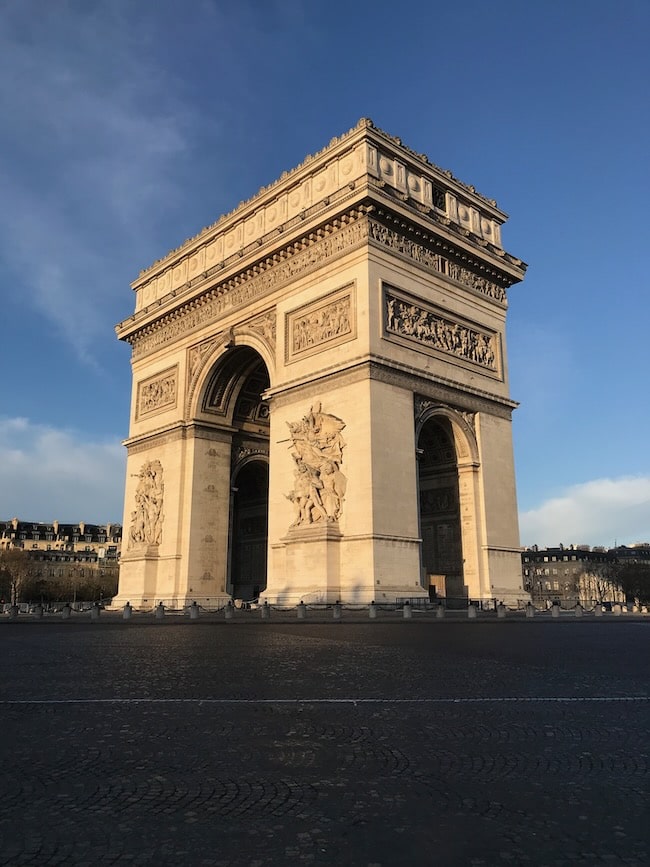 And as it is today, before the traffic starts on a Sunday morning
And as it is today, before the traffic starts on a Sunday morning14. Beware: you may not be insured
Think twice before plunging your car into the crazy traffic around l'Étoile.
There have been so many fender-benders here that French insurance companies got together and agreed to share the cost of any accident.
If you want to throw yourself on the mercy of Parisian drivers, check with your insurance first!
15. Today, major events are still celebrated here
While Victor Hugo's funeral procession was a huge public draw, it wasn't the only event of note to take place here.
Victories are the best remembered, like the victory parade at the end of World War I in 1918 or the march in 1944 during the liberation of Paris.
The Étoile remains a major rallying point, for better or worse. In 2018, the arch was vandalized by the Gilets Jaunes, or yellow vest protests against government plans to increase the retirement age to 64.
Partly location, partly historical weight, the most famous roundabout in Paris will continue its role in the city's major draws.
Place de l'Étoile FAQ
What is the meaning of the Place de l'Etoile?
Etoile means "star" in French, so the name is Square of the Star, named after its star shape.
What is the famous roundabout in Paris?
Place de l'Etoile, at the end of the Champs-Elysées.
What is the Arc de Triomphe famous for?
It was built in honor of the victories of Napoleon Bonaparte, but has been the scene of many momentous events – Napoleon's marriage, his loss to Russia, Victor Hugo's funeral, victories in World Wars I and II, and plenty of more modern celebrations and disruptions.
Which avenues lead to the Place de l'Etoile?
Wagram, MacMahon, Carnot, Grande Armée, Foch, Victor Hugo, Kléber, Iéna, Marceau, Champs-Élysées, Friedland, and Hoche.
Who has priority driving across the Place de l'Etoile?
Drivers arriving from the right have priority on the Place de l'Etoile. But one thing sets it apart from other roundabouts in France: people entering the roundabout have priority over those who are already in it.
What is the official name of the Place de l'Etoile?
Place Charles de Gaulle. The name changed from Place de l'Etoile in 1970 in honor of the former president and World War II hero.
How do you cross the Place de l'Etoile?
Use the underground crossing called Passage du Souvenir, or Remembrance Passageway. There are two entrances. One is where the Champs-Elysées joins the Etoile, and the other is opposite, on the corner of the Avenue de la Grande Armée.
How many roundabouts in Paris?
Strangely enough, Paris only has 8 roundabouts, and France as a whole has some 60,000.
Before you go...
Along with the Eiffel Tower and the Avenue des Champs-Élysées, the Place de l'Étoile is one of the most iconic sites of Paris.
But beyond these striking landmarks, there is a lesser-known Paris whose attractions are off the beaten path. Find them here!
Essential resources for your Paris trip
BOOK YOUR ACCOMMODATIONS
I use booking.com, because they include both hotels and holiday rentals like Airbnb or VRBO, so a wider choice and an easy cancellation policy.
DO YOU NEED A SIM CARD FOR FRANCE?
If you haven't signed up for a roaming service back home and have an unlocked phone, consider getting an e-SIM for France. Here's the one I use when I travel.
IF YOU'D LIKE TO READ UP ABOUT PARIS AND FRANCE
Drop by my long list of books about France, written by French or foreign Francophile authors, with plenty specifically about Paris.
AND DON'T FORGET YOUR GUIDEBOOKS!
➽ Lonely Planet's Paris Travel Guide
➽ Rick Steves' Paris
➽ Paris in Stride - An Insider's Walking Guide
A FEW WORDS ABOUT SAFETY
Paris is as safe as any major European city but you WILL find pickpockets in Paris. I keep them at bay by using a comfy anti-theft purse or an infinity scarf with a zipper to hide my cards and money.
Did you enjoy this article? I'd love if you shared it!
